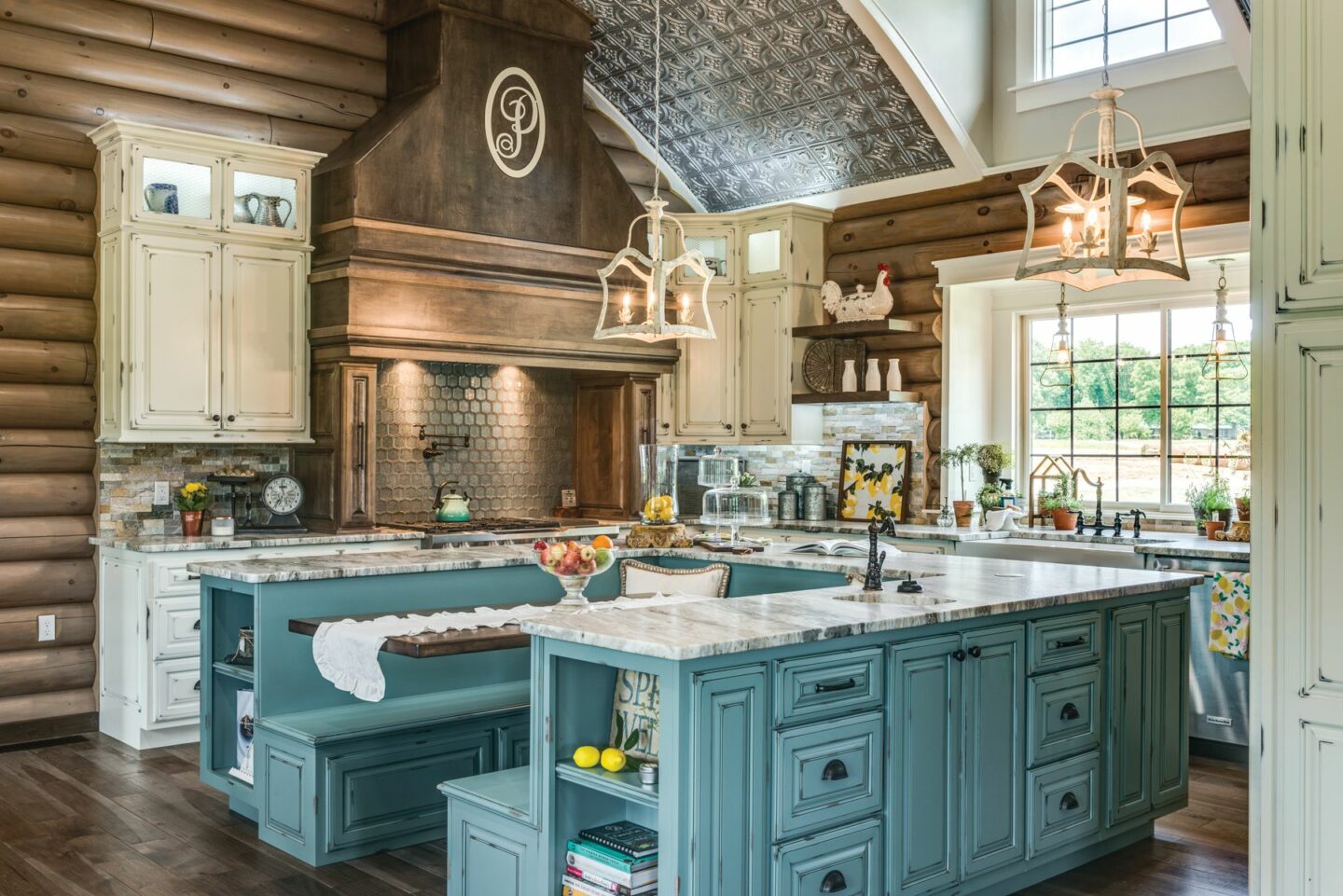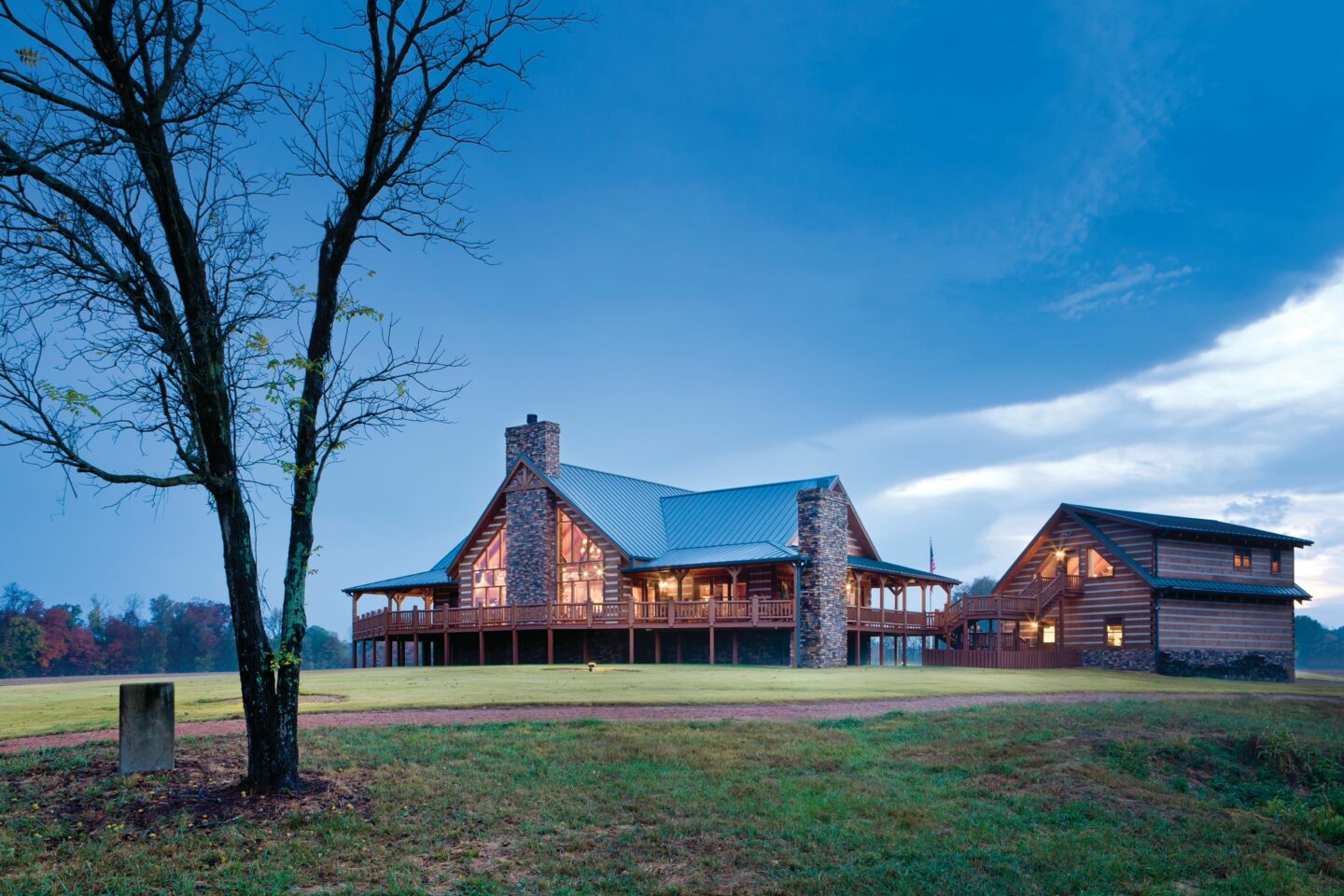Strategic use of color will complement and highlight the wood of your log or timber home.
We love the natural wood tones that dominate log & timber homes, from light honey to deep mahogany. The depth and warmth of wood is unparalleled, but the strategic use of color can highlight and complement any wood. Best of all, you don’t have to limit your use of color to furniture and accessories. There are many ways that you can use color to add drama and interest to both the exterior and interior and let your home reflect your personality.
What colors work best? Look for contrast. “In a log or timber frame home our base colors should always be tones of brown that can vary from slightly off white to very dark walnut,” says Allen Halcomb, president of MossCreek in Knoxville, Tennessee. “The trick is how do you build a palette of color values that is attractive and how do you accent that? The Craftsman colors from the 1930s and 1940s go well in a log or timber frame home,” says Halcomb. “That’s a safe way to introduce color to a home that has brown as the dominant color.” Think earthy russet, sage green, and buttery yellow.
Exteriors
A wonderful way to use color is on your home’s roof. Metal roofs are available in a broad spectrum of colors, but we most frequently see red, green, and black metal used on log and timber frame homes. Deep bronze and slate gray are becoming increasingly popular for metal roofs as well. It pays to be thoughtful about using color on your roof, as the large surface area makes it a focal
point, and you want to be certain you are choosing a look you can live with for the lifetime of the home.
Another way to add color to your exterior is to accent portions of the exterior with stained shingles, stucco, or painted siding. Stains in blues, greens, reds, and grays can be used to highlight a bay window or accent a covered porch. The trick is to limit your use of color to specific portions of the house so that the contrast with the natural wood allows both materials to shine.
Color is a great way to highlight trim, shutters, window frames, or even deck railings, if you choose a color that complements your home’s style. “Many window companies offer exterior window frames in wine, ebony, and evergreen that are a nice complement to a wood home,” says Alene Fisher, window specialist at Dunn Lumber in Bellevue, Washington. “Some window companies also offer custom color for window frames, so you can get precisely the look you want.”
“We are doing a house in Door County, Wisconsin, in the North Woods style,” says Halcomb. “The wood we used is very dark and the windows are dark red.” Halcomb adds that black is an excellent choice for wood homes; it can be used on windows, doors, and trim to give your home a more contemporary look.
Interiors
If you are using sheetrock or stucco on your interior walls, that’s a natural way to bring color into your home’s design. Painted or stained shiplap or even reclaimed wood can give rooms a cozy cottage feel. “The architecture is so big and dominant in a log or timber frame home, you usually don’t want to get too crazy with color on that,” says Halcomb, who advises looking instead for contrast. “You might have a dark floor and light walls, and then go back to add contrast so the timbers pop out.”

In the kitchen, if you have wood floors you might opt for painted kitchen cabinets instead of wood cabinets. “If you use all wood you may have missed an opportunity to add drama,” says Halcomb. Kitchens are also a great place to play with colored ceramic or glass tiles, or to install a quartz countertop in hues like teal and indigo. Concrete can also be stained in a variety of colors, like a coppery-green or terra cotta, and used for counters or floors.
Appliances come in many colors beyond the usual stainless steel. A dark red or cobalt blue enameled free-standing range with a copper vent hood would be a stunning focal point in any kitchen. You can get other appliances to match or pick just one as the showstopper.
“What you don’t see too often in a wood home is very bright reds or blues or things that would put you into the spectrum of bright colors,” says Halcomb. “That’s more often done in the décor.” Halcomb adds that as items become smaller you can pull off more creativity, like deep blue glass doorknobs or colored drawer and cabinet pulls. “As something gets bigger it needs to be more in the neutral territory,” he advises.
Smaller rooms—like bathrooms—are another place you can add color without fear of going overboard. “We recently completed a house where we used a wide hexagram tile in the master bathroom with red tiles mixed in,” says Halcomb. “When you get outside of the public areas into smaller scale rooms you can get a little more whimsical or daring.” Tumbled blue and green glass tiles reminiscent of beach glass are beautiful in a bathroom.
In many log & timber homes the fireplace anchors the living space. Use river rock in natural blues, grays, and greens to add some color and personality. Or use tiles to create an outdoor scene as the fireplace surround—perhaps a mountain view or a river with salmon swimming upstream.
Think of your log and timber home as a blank canvas. The judicious use of color to accent and highlight the natural wood can make the difference between a house that could belong to anyone and a home that reflects your own unique personality. Build a palette, think small, and have fun!

